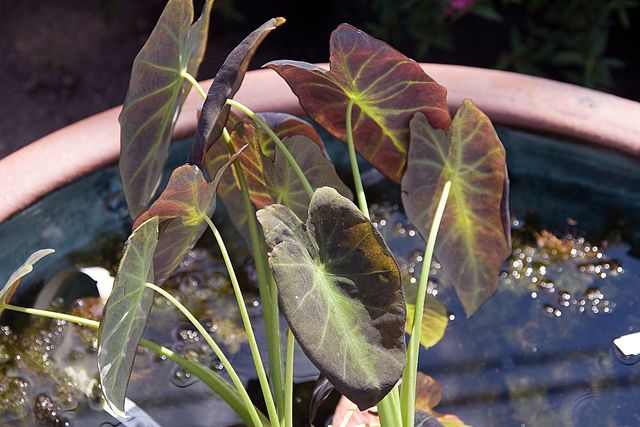Taro
Colocasia esculenta
Family: Araceae | Place of Origin: Southeastern Asia
Origins and history:
The Taro is a very agriculturally important plant in the world. As of 2018, it was the 9th in the world for food crop production. Taro has been cultivated for several thousand years and was originally found in South-East Asia. Over 2,500 years ago cultivation spread to Japan, now producers include Japan, islands in the Caribbean, Hawaii, throughout Africa, the Philippines, and South-East Asia. In Hawaii, Taro is associated with Hawaiian gods and ancestors. Its additionally believed to have the greatest life force of all foods, and is eaten ceremonially to celebrate family. The global import value of taro in 2019 was USD 179,309, major importers are New Zealand, Vietnam, and the United States.

Identification characteristics
- General: Taro is a monocot that has an average height of one to two meters and grows from the base of the corm rather than apically.
- Leaf morphology: The petioles are long and the leaves are large and heart-shaped with color ranging from green to purple. The plant does not flower often, as its main means of reproduction is asexual through corm production. Despite this, when inflorescences are produced, they are composed of a spadix and spathe with male flowers at the top of the spadix and female at the bottom, these are sheathed within the spathe.
- Root: It is widely known that Taro is eaten for its starchy root, however leaves can also be eaten as well.
Uses and preparation
All edible parts of the Taro plant are unsafe to eat unless cooked due to the calcium oxalate crystals present throughout the plant. The most common part eaten worldwide is the corm. Most often they are cut into cubes and boiled or fried. In the US, people will cut thin slices and fry them resulting in something similar to a potato chip. Leaves can be boiled or baked to break down the oxalates to make them safe to eat. They are high in protein and fiber and can be used as a vegetable such as spinach.
Taro is also commonly used as an ornamental plant. With a large variety of sizes and colors, they are often integrated into decorative landscapes and used as houseplants.